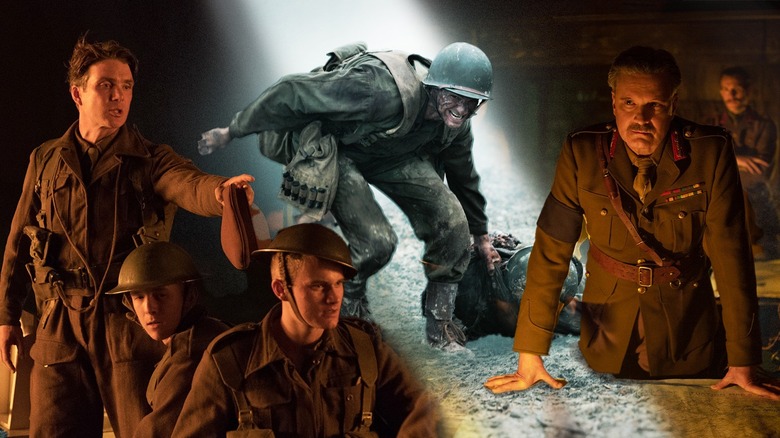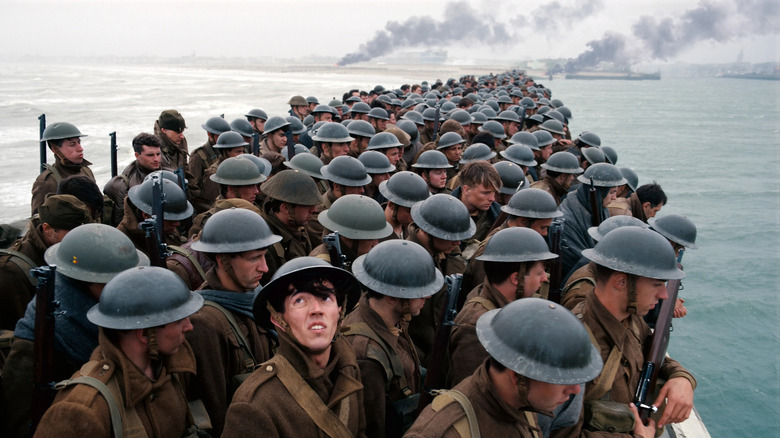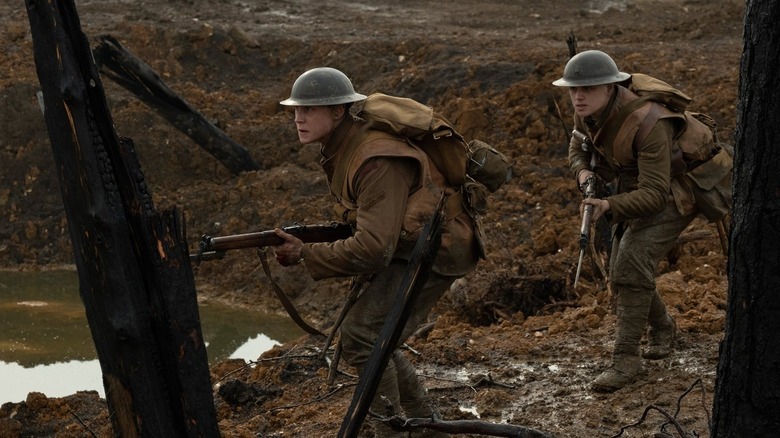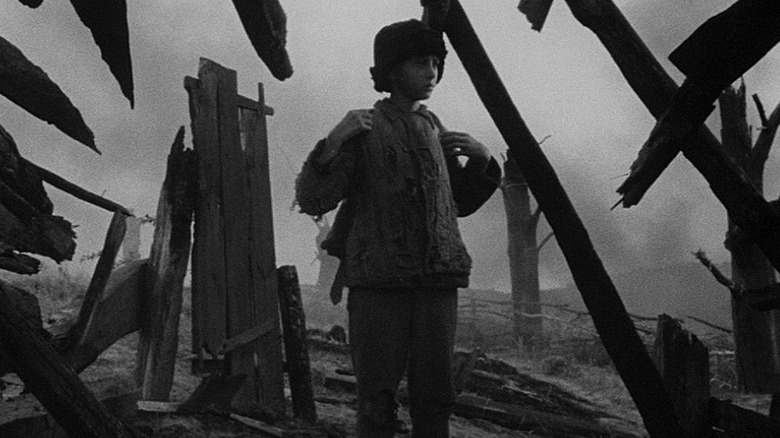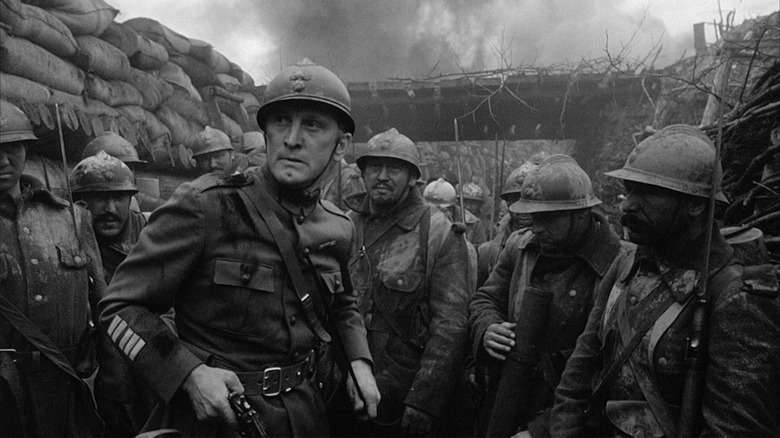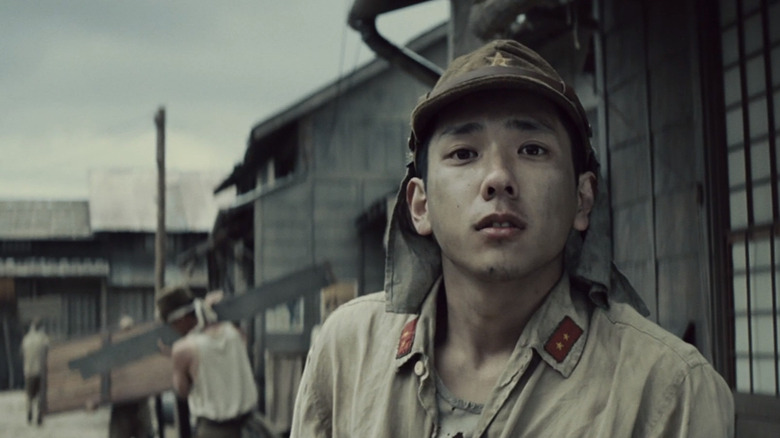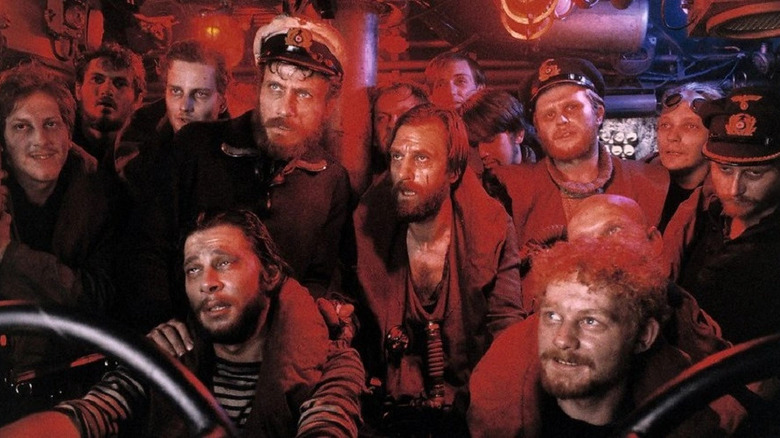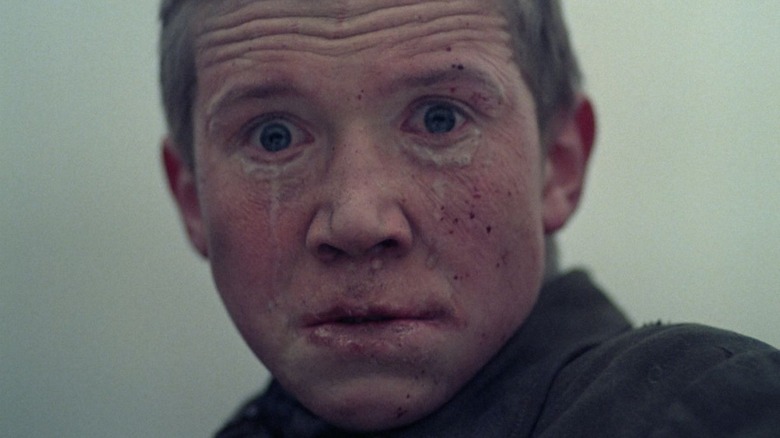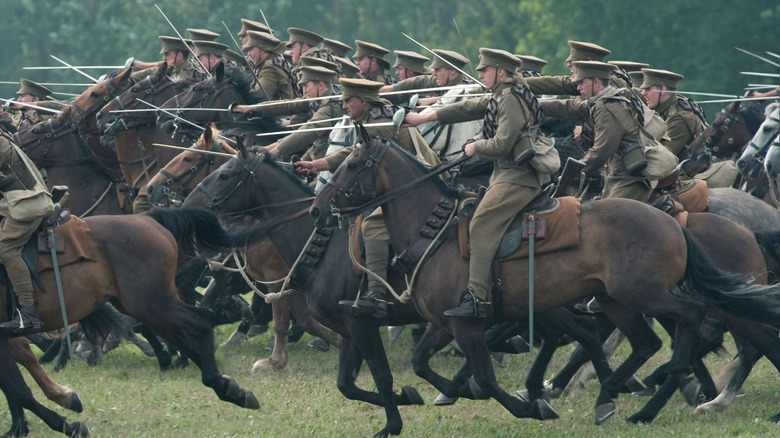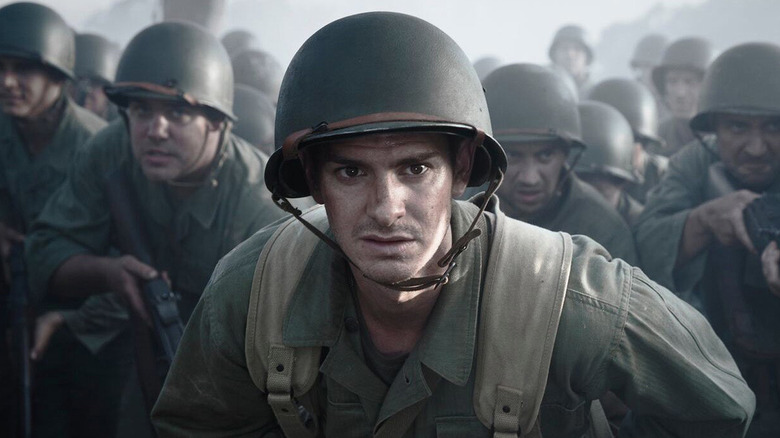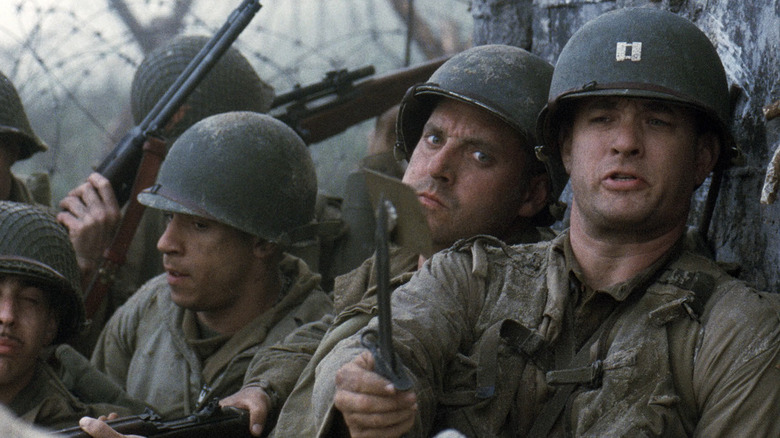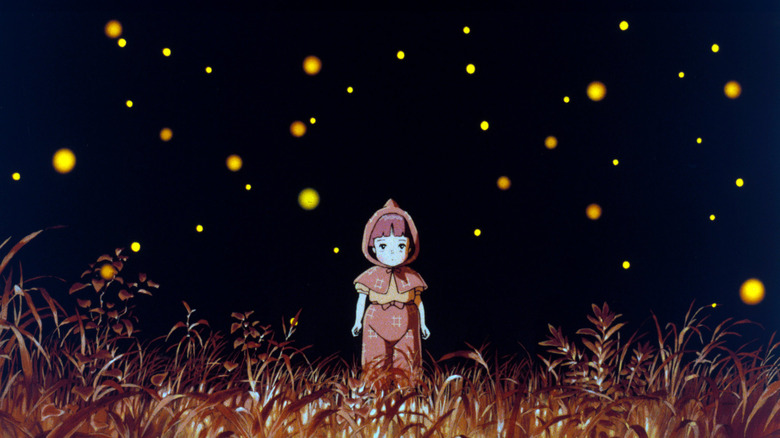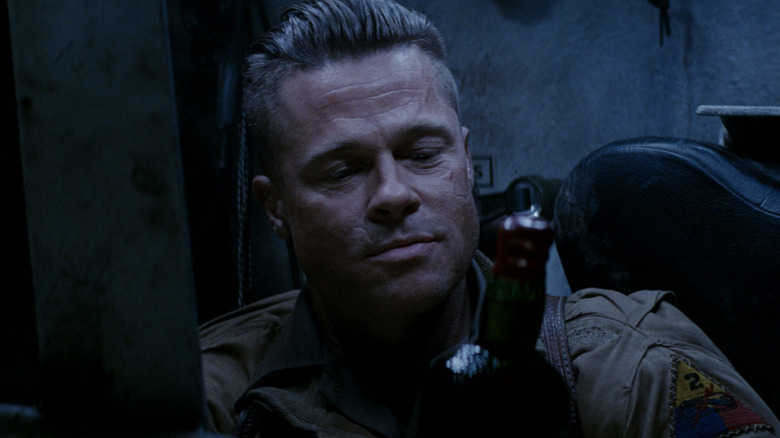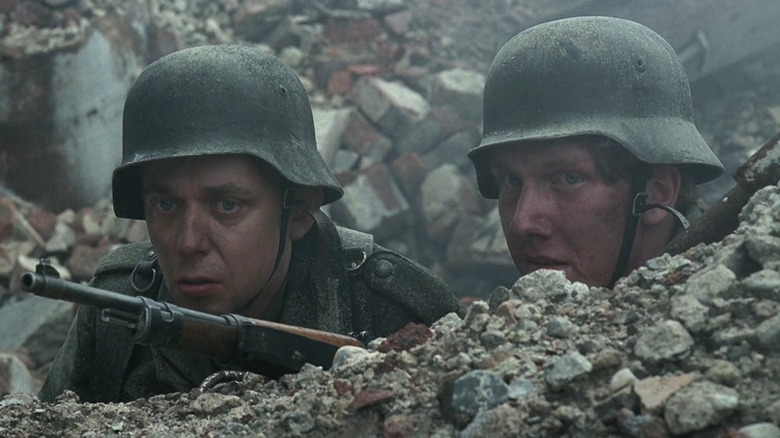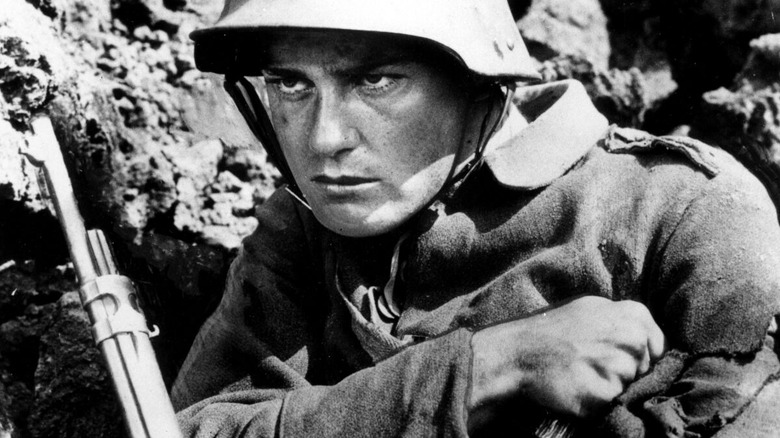14 Epic War Films To Watch If You Loved Netflix's All Quiet On The Western Front
Released in the autumn of 2022 and nominated for an impressive nine awards at the 95th Academy Awards, Edward Berger's "All Quiet on the Western Front" is the latest adaptation of the classic novel by German author Erich Remarque. A veteran of the First World War himself, Remarque sought to explore his own complicated feelings towards his experiences with the book, which has since gone on to become one of the most celebrated anti-war novels in history (via Smithsonian Magazine). The story follows Paul Bäumer, a young and idealistic German soldier whose heart and soul are forever changed by his time on the front lines of the war.
Remarque's novel helped create conversations about warfare and also helped inspire future filmmakers to expand upon those ideas. With that in mind, we'll be taking a look at some of the best war films across cinema history and picking out the ones most worth watching next for fans of "All Quiet on the Western Front."
Dunkirk
When it comes to films that can be described as "epic," perhaps none have mastered the art of making them more than Christopher Nolan. Films like "The Dark Knight" and "Inception" have earned him a reputation built on delivering cinematic and narrative experiences with few equals. Often helming films with elements of science fiction in them, "Dunkirk" was a surprisingly grounded project for the director and marked the first war film in his credits.
As the name suggests, it's set during the Allied evacuation of Dunkirk in 1940, when hundreds of thousands of Allied troops had been backed into a corner by a number of German victories (via History). With German forces at their backs and the perilous English Channel ahead, the Allied troops are left stranded on the beaches of Dunkirk in Northern France, which makes them ideal targets for Luftwaffe bombings. Their only hope for survival is to pray for a miracle, which comes in the form of a cobbled together fleet of civilian ships.
As in "All Quiet on the Western Front," "Dunkirk" does an incredible job of showcasing the scale of its portrayed conflict and is a standout entry among both Nolan's filmography and the wider world of war films.
1917
When it comes to war films, the Second World War tends to get the most attention from filmmakers. Whether that's because the conflict is better understood by most audiences or simply because it's more recent is hard to say, but what's certain is that any addition to the short list of films set during WWI is a warm welcome.
One of the only contemporary films to explore the war, "1917" begins with British Lance Corporals William Schofield (George MacKay) and Tom Blake (Dean-Charles Chapman), who are ordered to embark on a particularly dangerous mission. Tasked with traveling across enemy lines to intercept a British assault before it falls into an ambush, their failure would mean the needless slaughter of countless lives, with Lance Corporal Blake's brother among them.
Part thriller, part gripping war drama, the Academy Award-winning title is a breath of fresh air in the genre of war films, and has earned its reputation as one of the best in its class. Like "All Quiet on the Western Front," incredible effects, storytelling, and performances all combine to make "1917" a visually stunning and immersive experience.
Ivan's Childhood
While well-known among fans of Russian cinema, director Andrei Tarkovsky's debut film has often been passed over by international audiences, who may be more familiar with his later work like "Solaris," "Stalker," and "The Sacrifice."
Filmed entirely in black and white, his 1962 film "Ivan's Childhood" is both striking and at times downright surreal, as it portrays the deadliest conflict in human history from the perspective of a battered and vengeful 12-year-old boy named Ivan (Nikolai Burlyayev). The events of WWII have led him to risk life and limb fighting alongside partisans and against the invading German army, as he hopes to avenge the death of his family at the hand of the invaders.
Showcasing the human cost of war and its ability to transform even the most innocent into a shadow of their former selves, "Ivan's Childhood" is thematically very similar to "All Quiet on the Western Front." The somber tone and visuals further drive home the movie's anti-war themes, with the end result being one of the more haunting stories set during the conflict. While understandably short on heart-pounding action across sprawling battlefields that some war films aim for, "Ivan's Childhood" still readily conveys its thoughtful message.
Paths of Glory
Acclaimed director Stanley Kubrick incorporated many anti-war messages throughout his storied filmography in different ways and settings. Not long after the release of his 1953 film "Fear and Desire," Kubrick followed up on it with the release of "Paths of Glory," which examines the painful human cost of the First World War, as well as the careless attitudes leaders had towards the lives under their command.
The year is 1916 and the conflict has transformed from what the belligerents expected to be a quick victory into a total quagmire. On the French side of the battlefield, a suicidal order to capture a German position known as the Anthill is issued from senior leadership, and predictably ends in a slaughter for the assaulting troops.
The French leadership hopes to deflect responsibility by blaming the failed attack on the cowardice of the men in the trenches. Three of the soldiers get randomly selected for court martial and face a death sentence if they're found guilty. Their only hope rests in the hands of Colonel Dax (Kirk Douglas), who offers to plead the men's case at the trial, but he soon finds out that a search for the truth may not be his opponent's goal.
"Paths of Glory" was banned in France upon its release (via The New York Times) for its controversial and unflinching look at the army. A similar turn of events followed both the novel and original 1930 film adaptation of "All Quiet on the Western Front," which were banned in Germany for threatening the Nazi ideology (via Smithsonian Magazine), so those looking for another impactful anti-war film will find a brother-in-arms with "Paths of Glory."
Letters from Iwo Jima
Oftentimes, mainstream or popular films about WWI or WWII showcase the American or Allied point of view. It's a rare exception for viewers to get a glimpse into the plight of either the Central or Axis powers, which has left many longing for a new or more nuanced look at the conflict. Director Clint Eastwood set out to do just that, releasing both "Letters from Iwo Jima" and its companion piece "Flags of our Fathers" in 2006, which separately cover the Japanese and American perspectives of the devastating Battle of Iwo Jima (via Business Insider).
Despite the Pacific War's outlook being grim for the Imperial Japanese Army by early 1945, their will to continue fighting meant that every inch of territory would be a desperate struggle for both sides, which is where we enter "Letters." Undersupplied and with no hope of reinforcements, Private First Class Saigo (Kazunari Ninomiya) and the rest of the Japanese army on Iwo Jima are left with no choice but to defend the island, facing almost certain death in the coming battle.
If you're looking for another option like "All Quiet on the Western Front" that offers a fresh perspective on a well-known subject or are simply looking for another riveting entry in the genre, "Letters from Iwo Jima" is a must-see.
Das Boot
Some films deserve to be called epics thanks to their grand scale, dramatic visuals, or a combination of both. While "Das Boot" (simply "The Boat" in German) may not seem to meet those criteria at first glance, by the end it's sure to impress even the most skeptical of viewers.
This 1981 drama from director Wolfgang Petersen (best known by many for directing "The NeverEnding Story") follows the crew of the German submarine U-96, which is assigned to disrupt Allied shipping during the Battle of the Atlantic.
Similarly to "All Quiet on the Western Front," "Das Boot" is adapted from Lothar-Günther Buchheim's 1973 anti-war novel of the same name, and also explores the less seen German perspective of the World Wars.
Both films are centered around the effects that combat can have on people, especially when the idealism of those fighting clashes with reality. The crew of the cramped vessel's camaraderie, and at times lack thereof, is also a driving force of many of the events of "Das Boot." It adds another layer of tension and suspense to a film already teeming with both and make this essential viewing for any fans of war films.
Come and See
Given the staggering cost to human life that the Soviet Union was forced to endure during the Second World War, the films set during the conflict released in the years that followed often took on a far grimmer tone than their Western counterparts.
Elem Klimov's critically acclaimed 1985 film "Come and See" is a perfect and harrowing example of just how bleak these works could go. When Roger Ebert describes a movie as "one of the most devastating films ever about anything," you know you're in for something unlike anything you've seen before.
Set in Byelorussia (known as Belarus today), the film looks at the German occupation of the territory, which is marked by some of the worst atrocities of the war. A young boy named Flyora (Aleksey Kravchenko) bears witness to them all, as he quickly becomes embroiled in the partisan struggle against the occupiers.
Like Paul in "All Quiet on the Western Front," Flyora's dreams of heroism are shattered not long after he picks up a rifle, as his family becomes victims of the Germans. Thanks to its extreme content and realistic and unflinching approach, "Come and See" provides a truly eye-opening experience that won't soon be forgotten by viewers.
War Horse
Steven Spielberg's "War Horse" takes a unique approach to the depiction of World War I by focusing on an animal protagonist. This 2011 title — based on Michael Morpurgo's 1982 novel of the same name — follows the life and military service of a horse named Joey. While at first destined to be a farm animal, Joey winds up being sold to the British Army as a result of his owner's financial hardship. He soon winds up on the frontlines of the conflict, and narrowly avoids death before winding up in even more unexpected hands.
Though it aims for an entirely different tone than "All Quiet on the Western Front," "War Horse" still succeeds in depicting the same brutal realities for the average soldier in the First World War in many of its scenes. If you enjoyed any of the battle sequences in "All Quiet on the Western Front" or are simply looking for a war film with an angle unlike any other, "War Horse" is worth checking out.
Hacksaw Ridge
2016's "Hacksaw Ridge" is a gritty World War II drama about real-life Medal of Honor recipient Desmond Doss (via The National WWII Museum), played here by Andrew Garfield. A Seventh-day Adventist and conscientious objector who refuses to even carry a weapon, Doss nonetheless reports for duty when drafted and enters service as a combat medic.
He gets deployed in support of the Pacific War and is sent to the blood-soaked Battle of Okinawa. It is there that Doss's faith and courage is put to the ultimate test, which results in him saving the lives of 75 men from certain death.
While the first half of "Hacksaw Ridge" is a drama showcasing Doss's struggles at home to gain acceptance, both from the top brass of the Army as well as his peers, things heat up when the film finally reaches the Pacific. Featuring some of the most nail-biting action sequences on our list, it's a worthy follow-up to "All Quiet on the Western Front" that provides a similar anti-war message in an entirely different way.
Saving Private Ryan
It should only take a few minutes into "Saving Private Ryan" for audiences to pick up on its similarities to "All Quiet on the Western Front." The film begins with a blistering assault by Allied troops on the beaches of Normandy in a now iconic battle sequence that is famed for its unflinchingly accurate depiction of the conflict.
From there, a group of eight soldiers are tasked with bringing Private First Class James Ryan (Matt Damon), the last of four siblings still alive, home. First they'll have to find him though. It proves to be a nearly insurmountable task given the chaos of the ongoing invasion of Europe, as well as the fact that Private Ryan's whereabouts are unknown.
While we doubt many of our readers are unfamiliar with this one, "Saving Private Ryan" is such a tour de force in filmmaking that it deserves to be revisited by both casual film fans and history buffs alike. If you haven't gotten around to watching it yet, it'll be the perfect follow-up to "All Quiet on the Western Front," and you'll understand why it earned director Steven Spielberg his second Academy Award for Best Director.
Grave of the Fireflies
Set during the closing days of the war in the Pacific, Isao Takahata's "Grave of the Fireflies" — based on Akiyuki Nosaka's 1967 short story of the same name — is centered around the relentless American bombing campaign that was waged against the Japanese home islands. Carried out in the hopes of breaking the Japanese military's will to continue the fight, the assaults disproportionately affected the country's civilian population, which is where the story of Seita and Setsuko begins. Orphaned by the war, the young siblings are left with no choice but to rely on themselves — and one another — to try to survive the onslaught.
Released by acclaimed production company Studio Ghibli — of which Takahata was a co-founder — "Grave of the Fireflies" is notable both for its darker tone that's unlike the company's other famed releases like "My Neighbor Totoro" and "Spirited Away." It's also the only animated entry on our lineup but don't let that fool you; as Roger Ebert wrote, it "is an emotional experience so powerful that it forces a rethinking of animation."
"Grave of the Fireflies" captures the human cost of war better than most and deserves to be considered among any collection of amazing films set during WWII. While viewers won't find the same type of tense combat sprinkled throughout "All Quiet on the Western Front," they will find a similarly unforgiving look at the brutality of warfare.
Fury
By the spring of 1945, the war in Europe had nearly come to a close. Seeing the writing on the wall, many in the German military simply opted to surrender, while others instead chose to fight till the bitter end. "Fury" begins in Germany during the final days of the European theater, as Allied forces come face to face with a battle-hardened and increasingly desperate enemy.
Among the countless Allied tanks on the front line is Fury, an American Sherman with a crew of four, who have fought together through thick and thin. With the arrival of a rookie tanker to the crew, however, their effectiveness in combat and their chances of survival are both jeopardized.
Though some critics point out that this one trades a bit of realism in exchange for action, "Fury" makes up for it with its gritty tone. The sheer brutality and bleak nature throughout evoke the same feelings of dread that looms in "All Quiet on the Western Front," and leaves audiences wondering whether any of the Fury's crew will live to see the war's end.
Stalingrad (1993)
After a year of victories on the Eastern Front, the combined forces of the German military succeeded in pushing the Red Army back to the key city of Stalingrad. It was there that they would suffer one of the costliest defeats of the war (via History), resulting in what is now remembered by historians as one of the deadliest battles in human history.
Released in 1993, Joseph Vilsmaier's "Stalingrad" follows a group of German soldiers ordered into the thick of the crucial battle, where they come face to face with some of the most intense fighting of the war. The straightforward struggle for victory soon devolves into a desperate fight for survival, as the occupying German Army's supplies dwindle. Freezing, starving, and facing encirclement, they realize that desertion may be the only way to avoid death on the battlefield, but even abandoning their posts is easier said than done.
Much like "All Quiet on the Western Front," "Stalingrad" is unique for showcasing the German perspective of a similarly hopeless situation, and is sure to remind audiences of some of the more dire moments Paul and his fellow soldiers endured.
All Quiet on the Western Front (1930)
Perhaps no film is more like 2022's "All Quiet on the Western Front" than the original film adaptation that predates it by nearly a century. Released in 1930, little more than a decade after the conflict it portrays had come to a close, Lewis Milestone's film follows Paul's journey through the horrifying realities of trench warfare during the latter years of the fighting. Thanks to its strong message against the practice of war, the film, like the novel it's based on, was banned in Germany during the Nazi Party's rise to power (via The Hollywood Reporter).
While there are predictably many similarities between the 1930 film and the 2022 retelling, it seems there are just as many differences between the two. For example, the 1930 version includes a sequences from the novel in which Paul is granted leave from the front to return to his family, only to find that he can no longer relate to them. Plus, many characters' fates are different here from the 2022 film.
Despite the changes, however, both adaptations of Remarque's original novel retain their potent anti-war message, and both continue to resonate with the audiences of yesterday and today.
